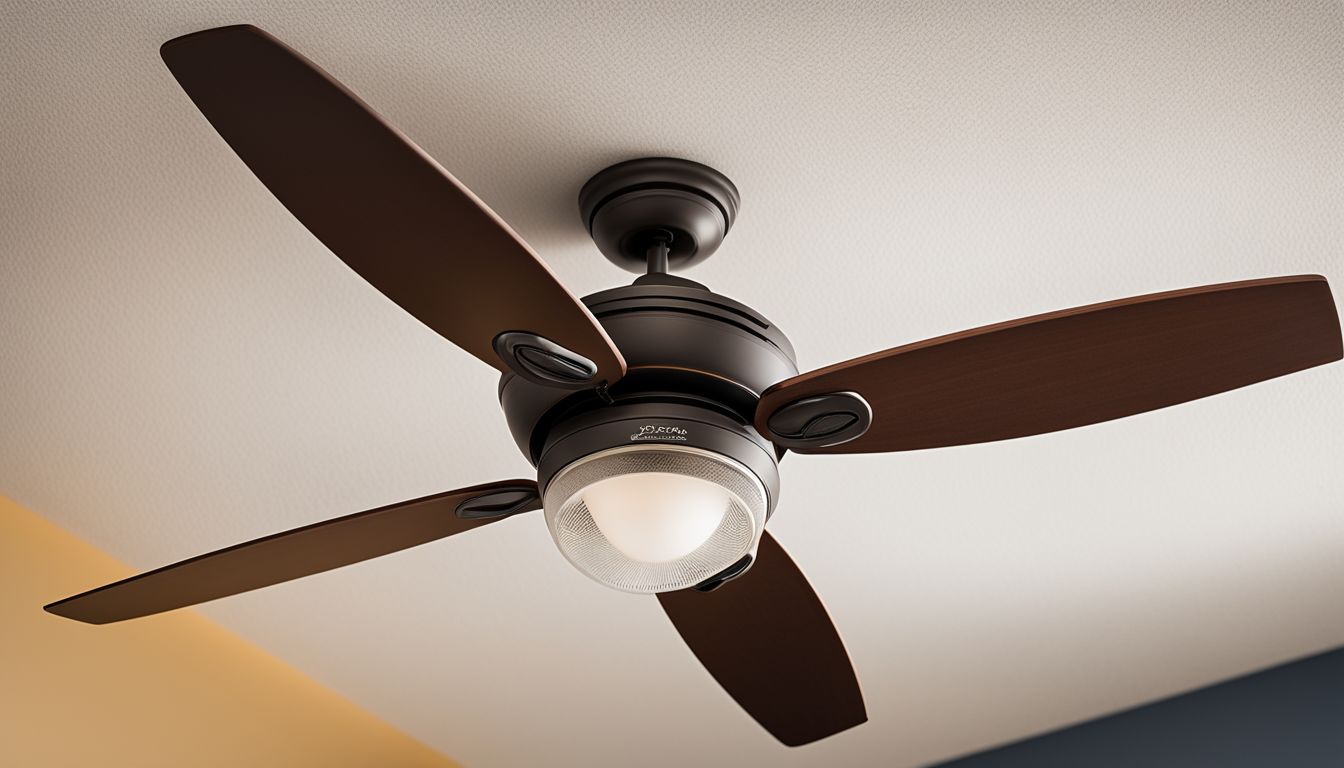Are you tired of your ceiling fan light flickering and ruining the ambiance of your room? Well, you’re not alone. Flickering ceiling fan lights can be a frustrating problem for homeowners everywhere. But fear not, because in this article, we will explore the common causes and provide simple solutions to fix it. So if you’re ready to enjoy a steady glow in your living space, let’s dive right in!
Key Takeaways
- Loose connections, outdated light bulbs, and incompatible dimmer switches can cause your ceiling fan light to flicker. These are some of the most common reasons for this issue.
- To fix the flickering issue, tighten bulb and connector connections, replace faulty light switches, balance the load on circuits, and repair or replace damaged wiring.
- If you’re unsure or uncomfortable working with electrical components, it’s best to seek professional help from a licensed electrician.
Why does your ceiling fan light flicker?
Your ceiling fan light may flicker due to a variety of factors. Loose connections, whether in the bulbs or the wiring, often cause this issue. Often, the vibration from your fan can gradually loosen these components over time, leading to an inconsistent connection and resulting in your lights flickering.
Older fans or those with improper installation might also contribute to flickering issues. If you use old bulbs or incompatible dimmer switches with newer bulbs like LEDs, it can create similar problems as well.
Hence ensuring all components are tight and up-to-date is key to maintaining steady lighting from your fan light fixture.
Common Causes of Ceiling Fan Light Flickering

1. Outdated or Old light bulbs
Old or outdated light bulbs often contribute to ceiling fan light flickers. The technology behind these bulbs, especially incandescent light bulbs and fluorescent ones, is not as durable or reliable as that in newer LED bulbs.
These older versions can begin to degrade with time and use, leading to inconsistent lighting patterns.
Flickering caused by old bulbs is more than an annoyance; it’s also a sign of wasted energy and potential harm to your home’s electrical system. As the filament inside an aged bulb struggles for consistent power, it starts producing the unwanted flicker effect.
Do not hesitate to replace the old or outdated incandescent or fluorescent bulbs with new low-wattage LED ones—the simple fix could stop your ceiling fan light from flickering while saving you money on your energy bill.

2. Dimmable light switch incompatibility
Dimmable light switches and LED bulbs often don’t mix well. These switches work perfectly with incandescent bulbs, regulating the flow of electricity to dim the bulb’s brightness.
However, LEDs operate differently – They use minimal energy which can lead to incompatibility with some dimmer switches.
To stop this annoying flicker, you might need a switch upgrade compatible with LED light bulbs or an easy fix would be to replace your led lights with incandescent ones. Don’t let incompatible dimmers diminish your love for low-wattage LED bulbs; explore options that allow you to enjoy both energy efficiency and smooth lighting operation.
3. Loose light bulb connection
A loose light bulb connection often triggers flickering in ceiling fan lights. Continual use of your ceiling fan may lead to light bulbs and connectors becoming less secure over time.
Plus, the subtle vibrations generated by a functioning ceiling fan can exacerbate this loosening over the long haul. To mitigate such issues, regularly ensure that all bulbs are tightly screwed into place to maintain a solid electrical connection and prevent unnecessary flickering.
4. Old light switches
Over time, the connections between the old switches and bulbs may become loose or worn out, leading to poor electrical contact. Additionally, old wiring in your home could contribute to this issue, as it may not provide a consistent electrical flow.
This can result in intermittent flickering of your ceiling fan light. To fix this issue, it is recommended to replace the old light switches with new ones that provide secure and stable connections for your bulbs.
By doing so, you can ensure a steady and consistent flow of electricity to your ceiling fan light, eliminating any flickering problems caused by outdated switches, ensuring no faulty wiring is present.
5. Old ceiling fans
Old ceiling fans are often the culprit behind flickering lights. The vibrations caused by running these older fans can loosen wiring connections, leading to flickering in the lights.
Additionally, loose bulbs in old ceiling fans can also cause flickering. Over time, as the fan operates, the bulbs may become loose and start flickering. Therefore, if you have an old ceiling fan and are experiencing light flickering issues, it is worth checking the wiring connections and tightening any loose bulbs to resolve the problem.
6. Bad current limiter
A wattage limiter, or current limiter, can decrease your ceiling fan’s energy consumption but may lead to flickering lights if it begins to fail. When the current limiter malfunctions, it can disrupt the flow of electricity and cause the light to flicker intermittently.
This instability in electrical current can be frustrating and annoying. However, addressing and replacing a bad current limiter can help resolve the issue of flickering lights in your ceiling fan.
It is important to check the current limiter as a possible solution. By identifying and fixing this problem, you can enjoy stable lighting in your home once again.
7. Overloaded circuits
Overloaded circuit can be a common cause of ceiling fan light flickering. When there are too many appliances and devices drawing power from the same circuit, it can put a strain on the electrical system.
This increased demand for electricity may result in flickering lights, including those connected to your ceiling fan. To fix this issue, you may need to redistribute the load on the circuits or consider adding additional circuits to handle the extra power requirements.
Ensuring that your electrical system especially in older homes, is properly balanced can help prevent flickering caused by overloaded circuits.
8. Loose wiring
Loose wiring is another common cause of ceiling fan light flickering and can also be indicative of underlying electrical issues. Over time, the vibrations from the fan can cause the wiring connections in the light fixture to become loose. When this happens, it can disrupt the flow of electricity and lead to flickering lights. If the issue persists, it may be necessary to call in a professional for an electrician repair service.
Checking and tightening any loose wires in your ceiling fan’s light assembly can help resolve this issue and eliminate the annoying flickering effect.
How to Fix Ceiling Fan Light Flickering DIY

To fix ceiling fan light flickering, start by tightening the bulbs and connectors to ensure a secure connection. Check the voltage stability and replace faulty light switches if necessary.
Balancing the load on circuits can also help prevent flickering. If all else fails, consider repairing or replacing the wiring in your ceiling fan.

Tightening bulbs and connectors
To fix the flickering of your ceiling fan light, start by tightening the bulbs and connectors. Ensure that all bulbs are securely screwed into their light sockets. Check for any loose connections between the light fixture and the wiring.
Checking voltage stability
To fix the flickering of your ceiling fan light, it is important to check the voltage stability in your home. Here’s what you can do:
- Use a voltage tester to check if there are any fluctuations in the electrical current.
- Inspect the circuit breaker panel to ensure all breakers are properly connected.
- If you have dimmer switches, make sure they are compatible with your light bulbs and adjust them accordingly.
- Consider installing a voltage stabilizer or regulator to regulate the electrical flow.
- Consult a professional electrician if you suspect any major issues with the electrical system in your home.
Replacing faulty light switches
- Faulty light switches can cause flickering lights in ceiling fans.
- A high – quality, compatible switch should be used to replace any faulty light switches.
- This replacement can help resolve the issue of flickering lights.
- Poor connections between the switch and the bulb can result in flickering of ceiling fan lights.
- Intermittent flickering may occur if there were poor connections made during installation.
- Flickering lights, especially when using LED bulbs, may be caused by faulty light switches.
- The flickering issue can be eliminated by replacing the faulty light switch with a compatible one.
- It is important to properly install the light switch to prevent any flickering of ceiling fan lights.
Balancing load on circuits
To fix flickering lights on your ceiling fan, one of the steps you can take is balancing the load on circuits. This helps to ensure that the electrical current is distributed evenly, preventing any overload that may cause the lights to flicker. Here are some ways you can balance the load on circuits:
- Identify which circuit is causing the flickering lights and determine if it is overloaded.
- If the circuit is overloaded, try redistributing the electrical load by plugging certain appliances into different outlets.
- Consider using power strips or surge protectors to distribute the load more evenly across multiple outlets.
- If needed, consult with a professional electrician to assess and adjust the electrical wiring in your home to balance the load effectively.
In addition to these steps, make sure that the ceiling light is not on the same circuit as large appliances which can cause significant fluctuations when they power on or off.
Repairing or replacing ceiling fan wiring
If you’ve determined that the wiring in your ceiling fan is causing the light to flicker, here are some steps you can take to repair or replace it:
- Turn off the power: Before working on any electrical components, make sure to turn off the power to the ceiling fan at the circuit breaker.
- Remove the canopy: Unscrew and remove the canopy that covers the wiring connections at the ceiling. This will give you access to the wiring.
- Inspect for damage: Carefully examine the wiring for any signs of damage, such as frayed or exposed wires. If you notice any issues, it’s best to replace the entire section of wiring.
- Replace damaged wiring: Using wire cutters, remove the damaged section of wiring and strip about half an inch of insulation from each end. Connect a new piece of wire using wire nuts and secure them tightly.
- Reconnect wires: Match up the color-coded wires (usually black to black, white to white) and twist them together with wire nuts. Make sure they are securely fastened. At this point, if you’re also looking to add or replace a light kit, ensure that its wires are correctly connected to the fan’s wiring.
- Test for stability: After making all necessary repairs or replacements, turn on the power and test if the light still flickers. If it does, double-check all connections and redo them if necessary.
When to Seek Professional Help
If you encounter complex wiring issues, lack experience or expertise in electrical work, or are unsure about electrical safety precautions, it is best to seek professional help from a licensed electrician.

Electrical safety precautions
To ensure your safety when dealing with flickering ceiling fan lights, it is important to take electrical safety precautions. Always turn off the power at the circuit breaker before attempting any repairs or inspections.
Use insulated gloves and tools specifically designed for electrical work. Avoid working in wet conditions, as water can amplify the risk of electric shock. It’s also crucial to avoid overloading circuits by using appropriate wattage bulbs and not plugging too many appliances into the same outlet.
If you are unsure about any electrical work or if the flickering persists after trying DIY fixes, it is best to seek professional help from a licensed electrician who can accurately diagnose and resolve any underlying issues.
Complex wiring issues
Complex wiring issues can be a major cause of flickering ceiling fan lights. These issues may include faulty or outdated wiring, improper connections, or overloaded circuits. It is important to address these problems promptly as they can lead to electrical hazards and even fires.
Seeking professional help from a licensed electrician is highly recommended for diagnosing and resolving complex wiring issues to ensure the safety and proper functioning of your ceiling fan lights.
Lack of experience or expertise
If you lack experience or expertise in electrical work, it is best to seek professional help when dealing with flickering ceiling fan lights. Electrical systems can be complex and require specialized knowledge to diagnose and fix issues safely.
Professionals have the training and equipment needed to handle electrical problems without putting yourself or your home at risk. They can also ensure that proper safety precautions are taken during repairs, reducing the chance of electrical fires or further damage.
When faced with flickering lights caused by wiring issues or other electrical problems, contacting a licensed electrician is the best course of action to resolve the issue effectively.
Conclusion
In conclusion, flickering ceiling fan lights can be a frustrating problem for homeowners. Loose connections, faulty switches, and voltage fluctuations are common causes of this issue.
However, there are several easy fixes such as tightening bulb connections and replacing faulty switches that can help resolve the problem. If these solutions don’t work, it may be necessary to seek professional assistance from an electrician to diagnose and fix the underlying cause of the flickering lights.
Regular maintenance and inspection of your ceiling fan can also help prevent future flickering issues.
More from Materialsix:
